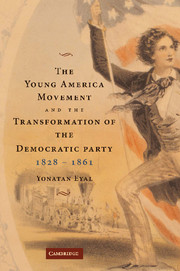Book contents
- Frontmatter
- Contents
- Acknowledgments
- Introduction: The Spirit of Young America
- 1 Orthodox Jacksonianism, 1828–1844
- 2 Trade and Improvements: The Economic Orientation of Young America Democrats
- 3 Rails, Canals, and a New Commercial Spirit
- 4 Young America Democrats and the Revolutions of 1848
- 5 A New International Consciousness
- 6 The Fires of Perfection Revisited
- 7 The Antislavery Democracy
- 8 New Democrats and the Coming of the Civil War
- Conclusion: Lincoln on Young America
- Index
1 - Orthodox Jacksonianism, 1828–1844
Published online by Cambridge University Press: 31 July 2009
- Frontmatter
- Contents
- Acknowledgments
- Introduction: The Spirit of Young America
- 1 Orthodox Jacksonianism, 1828–1844
- 2 Trade and Improvements: The Economic Orientation of Young America Democrats
- 3 Rails, Canals, and a New Commercial Spirit
- 4 Young America Democrats and the Revolutions of 1848
- 5 A New International Consciousness
- 6 The Fires of Perfection Revisited
- 7 The Antislavery Democracy
- 8 New Democrats and the Coming of the Civil War
- Conclusion: Lincoln on Young America
- Index
Summary
“Equal opportunity for all, special privilege for none.”
“The best government is that which governs least.”
– Democratic slogansAmericans like to think they never experienced a true revolution, in the socially transformative, European sense of the word. As a substitute for this void, they apply the term to numerous events in their history. One of the first instances came when Thomas Jefferson won election to the presidency in the “revolution of 1800.” Jefferson had long valued upheaval, most recently of the French variety, although in this case the transition in question remained peaceful. Unseating the Federalist ascendancy of John Adams and Alexander Hamilton, Jefferson brought to the executive department of the central government a wholly different worldview.
Hamilton and the Federalist Party cherished a “loose” construction of the U.S. Constitution, one that inflated the powers of the federal government in order to meet the needs of a growing republic. Jefferson and his followers played watchdogs, insisting that a restrictive interpretation of the charter would maintain economical government and prevent the growth of despotism, or what they called “consolidation.” Federalists envisioned national growth within limited territorial bounds, as infrastructure such as roads created a vibrant national economy. Jefferson instead conjured a sprawling “empire of liberty” that would accrue land for the virtuous farmers whom he considered the salt of the earth. Federalists saw the benefits of governmental alliance with a monied aristocracy, since wealth invested in national coffers stood to benefit the entire polity.
- Type
- Chapter
- Information
- Publisher: Cambridge University PressPrint publication year: 2007



